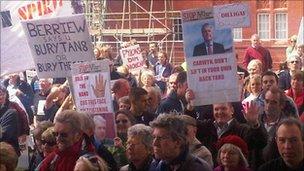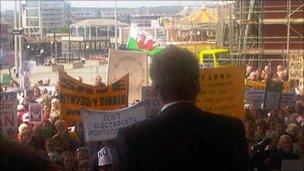'A voice that cannot and should not be ignored'
- Published
- comments

Protesters outside the Senedd
Llangadfan, Berriew, Mynydd y Gwair - the coaches and cars carrying home well over a thousand protesters against hundreds of new wind turbines and pylons in Montgomeryshire have long since left the Senedd.
There were some blunt messages on their posters and though not quite as blunt or clear-cut in return, here are some messages from ministers the protesters might be interested in reading.
This morning, both the First Minister and the Welsh Secretary were addressing the Renewable UK Conference in Cardiff. Read between the lines and those people who've packed their placards away for now may well feel their journey was worthwhile.
To recap, as part of its drive to meet carbon reduction targets, the previous Welsh Government, through its TAN 8 guidance, designated a number of upland areas of Montgomeryshire as "Strategic Search Areas" - land they identify as suitable for wind farm developments.
A significant number of proposals have been made, external but what's also emerged is the scale of the transmission infrastructure - pylons, cables, and substations - that the National Grid will have to install in order to get the power from the windfarms to where it's needed.
And it was these plans which had enraged those who came down to take part in the largest ever demonstration outside the Senedd earlier this week.
Responsibility for planning on energy projects is split between Cardiff Bay and Westminster. This morning, the Welsh Secretary Cheryl Gillan gave the clearest possible signal that she believes the protesters have a point and that there should be a rethink:
"...we recognise that onshore wind developments can prove controversial. We have seen only this week how strong feelings can be.
"Our view is that on-shore wind energy does have a role to play in our energy mix. The only way to meet the stretching climate reduction targets we have set is by all low carbon forms of energy playing a role.
"But that does not mean that politicians or developers can ride roughshod over local opinion. Rather, they should work with communities to ensure that proposals have local support and are sympathetic to the environment around them.

Glyn Davies MP: 'This is our Tryweryn'
"The people of Powys made that loud and clear when more than a thousand people demonstrated outside the Senedd on Tuesday. Theirs is a voice that cannot and should not be ignored."
That's a powerful - pardon the pun - endorsement of the protesters case and an implicit rebuke for the Welsh Government's decisions on those strategic search areas, as well as the planning process since.
Part of Carwyn Jones' election pitch to become First Minister again was that he would take personal responsibility for energy issues, which he has duly done. He didn't address the Senedd protest on Tuesday and watching the protest from the sidelines, I heard the chants of "Where Is He...Where Is He" at the mention of his name as clearly as anyone.
Mr Jones didn't address the Powys protest directly in his speech today but he did allude to the sometime "fraught" decisions which will have to made in meeting those energy targets.
"As we enter this new period, we must ensure that the public understand both what is happening and why it is happening. Without this for example the planning process, whether for devices or grid connections at scale, will continue to be fraught".
What does this tell us? Is this people power in action? Well, yes. But words are one thing and the planning process is another, quasi-judicial system. And while the politicians may have been swayed to a greater or lesser extent by the protests, you can be sure that it won't have altered the bottom line figures for a single one of the developers behind the proposed wind farms themselves.